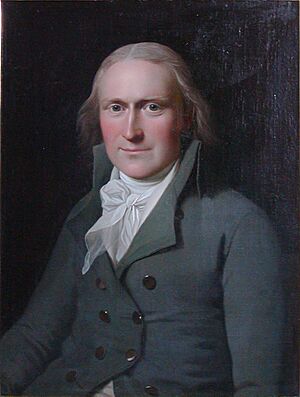Peter Andreas Heiberg facts for kids
Peter Andreas Heiberg (born November 16, 1758 – died April 30, 1841) was a writer and language expert from Denmark and Norway. He was born in Vordingborg, Denmark. His family had a long history in Norway, with many priests and teachers. His father was a headteacher, and his mother came from a family of wealthy merchants.
Contents
Peter Andreas Heiberg's Life
Early Life and Education
Peter's father passed away when Peter was only two years old. His mother then moved with the children to live with her father. This was Peter's home until he went to grammar school, where he finished his studies in 1774. He continued his education, focusing on languages.
Becoming a Writer
In 1779, Peter left Copenhagen. He then went to Sweden and joined the military for a short time. After his family helped him leave the military, he spent three years in Bergen, Norway. There, he met many writers who inspired him to start writing his own stories and poems.
When he returned to Copenhagen, Peter used his excellent language skills to work as an interpreter. He also translated a book by a French writer, Jean-Charles Laveaux. This book was very critical of the upper class, so Peter published his translation without his name on it. In 1790, Peter married Thomasine Buntzen. They had a son named Johan Ludvig.
Peter Heiberg admired many French thinkers and their ideas from the Age of Enlightenment. This was a time when people believed in using reason and science to improve society.
His Writings and Exile
Peter Heiberg's first novel, Rigsdalersedlens Hændelser (which means The Events of the Rigsdaler Note), came out in 1789. In this book, he openly criticized merchants, noble families, and the strong German influence in Denmark. This made many powerful people in Denmark very angry.
Despite the anger, Peter continued to write critical songs, articles, essays, and plays. One of his plays, Heckingborn, was even translated into English. His strong political criticism eventually led to him being sent away from Denmark on Christmas Eve, 1799. He had received many warnings and fines for his writings. However, after new, stricter laws about what writers could say were introduced, he was accused and sentenced to leave the country. After this, Peter Heiberg moved to Paris, France, where he lived until he passed away in 1841.
Selected Works
- Indtogsvise (1790)
- Rigdsdaler-Sedlens haendelser (1787–93)
- Sprog-Grandskning (1798)
- De vonner og vanner (1793)
See also
 In Spanish: Peter Andreas Heiberg para niños
In Spanish: Peter Andreas Heiberg para niños


